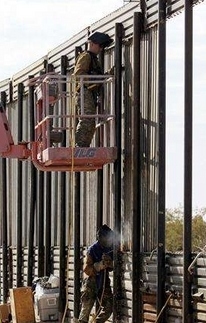Despite fences, immigrants still broach US border
Updated: 2008-03-03 15:53
SAN LUIS, Ariz -- Daily, US Border Patrol agents in this Arizona town faced groups of up to 200 illegal immigrants who would swarm across the border from Mexico, sprinting past the agents to a new life in the United States.
That was until 18 months ago, when the single fence was bolstered by two taller, steel barriers, watched over by video cameras and lit by a blaze of stadium lighting. Now the incursions known by the agents as "Banzai Runs" have all but stopped.
|
|
"It was overwhelming," said agent Andrew Patterson. "This used to be a huge trouble area, now we are almost down to zero."
The troubled patch of borderlands in this speck of a town in far west Arizona is among many places along the almost 2,000-mile (3,200-km) US-Mexican border that are getting new fencing as part of a US initiative to stem the flow of illegal immigrants.
Washington plans to build 670 miles of barriers, including pedestrian and vehicle fences, by the end of 2008. So far, more than 300 miles have been built, and the government is pushing hard in this election year to finish them, as mandated by the US Congress.
While they are controversial -- some border landowners resent what they see as unwelcome government intrusion and some conservationists argue it disrupts wildlife flows -- border police say this stretch of new fencing has been highly effective.
"It has been a massive success. It has allowed our agents to gain control over the area and acted as a deterrent for people thinking of crossing," said Jeremy Schappell, a spokesman for the Border Patrol's Yuma sector, which includes San Luis.
SLOWING THE FLOW
Illegal immigration is a hot-button topic in the United States. A pledge to secure the porous southwest border with a combination of new barriers, increased manpower and new surveillance technologies is routinely made by both Democratic and Republican candidates seeking to be their party's pick to run for president in November.
The barrier erected in San Luis is similar in design to those pioneered in San Diego, California, and El Paso, Texas, in the 1990s, which helped the Border Patrol regain control of what were then the most heavily transited areas of the border, crossed by hundreds of thousands of illegal immigrants each year.
The El Paso barrier -- two parallel chain link fences over 15 feet in height spaced 30 feet apart along the bed of the Rio Grande -- helped cut the number of illegal border crossers and curbed crime in the city, residents say.
The barrier has no barbed wire and includes several formal breaks, one where a freight train crosses from Ciudad Juarez, in Mexico, another to give access to the river bed, and is watched around the clock by border police spaced at intervals along the line.
But without 24-hour monitoring, as well as the stadium flood lights, and the directional cameras linked to a central control room manned by National Guard troops, the El Paso fence would be little deterrent.
"Along this stretch, the fence in itself doesn't stop anyone, but it does slow them down and gives us time to react. Those extra seconds are vital, and that's what a lot of people don't realize," said agent Jose Cisneros.
"You don't just put up a fence and say that is the end of it."
MOMENTS TO REACT
Graffiti is scrawled on the Mexican side of the gray concrete bed of the Rio Grande, while huge, cross-border highway bridges run over the top.
|
|
|
||
|
||
|
|
|
|


